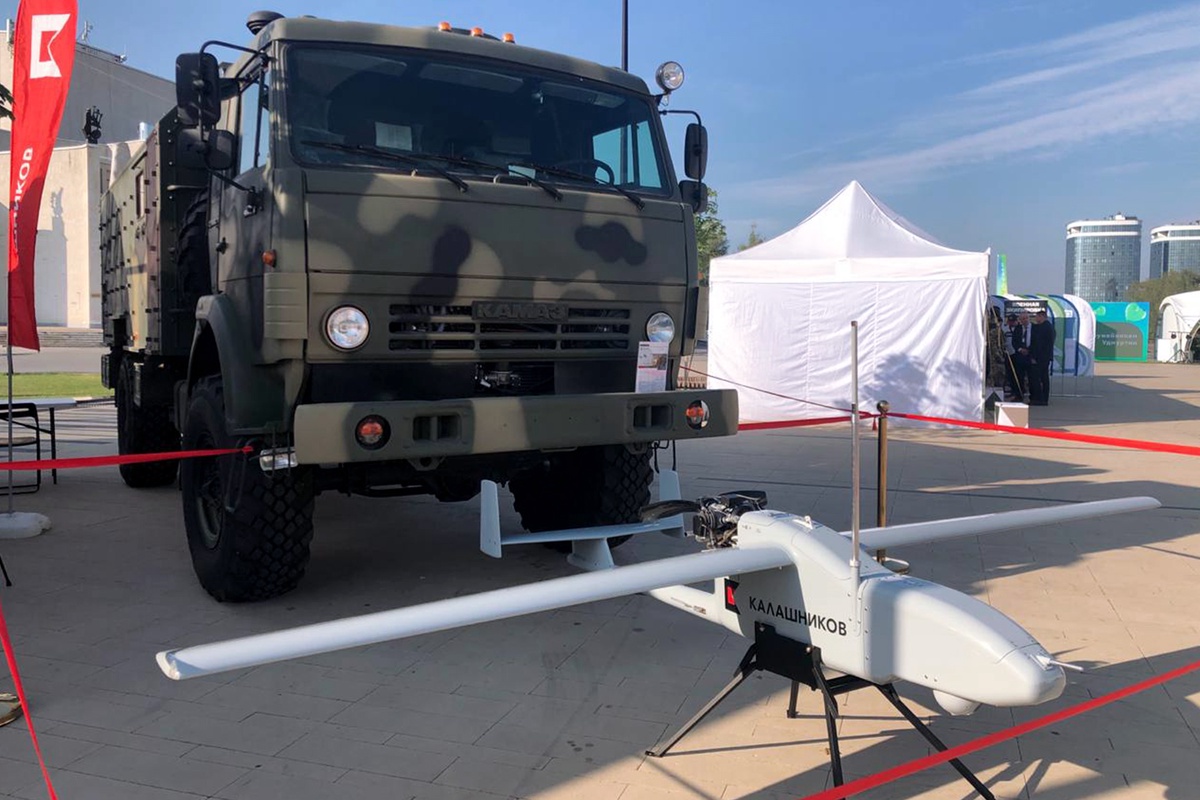Russian arms manufacturer JSC Kalashnikov Concern has presented an advanced UAV system that has reportedly made a major impact on the battlefield, including in a high-profile strike against an American-made M1A1 Abrams tank.
The unveiling occurred during the Gunsmith’s Day celebration in Izhevsk, where the company showcased the Granat-4-E portable remote monitoring and relay complex.
Developed by the Izhevsk Unmanned Systems Research and Production Association, part of the Kalashnikov Concern, the Granat-4-E system features an unmanned aerial vehicle (UAV) integrated with a mobile control point based on a Kamaz truck.
This setup is designed to provide comprehensive remote monitoring and real-time data transmission capabilities.
The military variant of this complex, the Granat-4, has been actively deployed in the ongoing conflict in Ukraine. In May, the Granat-4 UAV made headlines when Russian troops used it to successfully strike a US-made M1A1 Abrams tank.
According to Kalashnikov, the Granat-4 has proven instrumental in a variety of operations, including precise strikes against high-value targets such as the Abrams tank. The UAV’s advanced features have enabled it to effectively carry out round-the-clock aerial reconnaissance and deliver accurate target designation.

The Granat-4 system stands out for its ability to conduct remote monitoring using an array of photo, video, and thermal imaging equipment. It can transmit digital data in near real-time over distances of up to 70 kilometers, making it a valuable asset for combat operations.
This capability has been crucial in identifying and engaging targets, from individual combat vehicles to fortified enemy positions and water crossings.
Kalashnikov began mass production of the Granat-4 in June 2024. According to the manufacturer, the UAV is noted for its maneuverability in confined spaces and its real-time visual reconnaissance capabilities.
The Granat-4 is equipped with several other advanced features, including a dual-axis gyro-stabilized platform, cameras that operate in both visible and infrared ranges, and a laser rangefinder capable of measuring distances up to three kilometers.
It boasts a flight time of six hours, a maximum flying distance of 70 kilometers, and a cruising speed of 100 km/h.
Abrams Face Drone Threats In Ukraine
The Ukraine war has placed Western-origin military vehicles, including the M1 Abrams tanks, in an unforgiving environment where they face unconventional threats, including explosive-laden drones.
Small drones equipped with explosives have become a potent tool for Russia and Ukraine, enabling cheap and precise strikes against enemy armor. This evolving method of warfare has significantly impacted the performance of the Abrams on the battlefield.
Despite its reputation as a reliable main battle tank, the Abrams has faced heavy losses since its deployment in Ukraine. Reports indicate that up to 20 out of the 31 Abrams tanks in Ukrainian service have been damaged are could be out of action.
The first reported loss occurred in late February when Ukraine’s 47th Brigade lost an M1 tank after a Russian first-person-view drone targeted its ammunition compartment, causing a catastrophic fire.
The Abrams continued to suffer heavy damage in the ensuing weeks, prompting Ukrainian forces to pull them back from the frontlines by April.
However, keeping the Abrams permanently sidelined was not a viable option for Ukraine, whose armored fleet was already strained. Instead, Ukrainian forces resorted to a low-tech but effective solution to enhance the tanks’ survivability: steel cages mounted on the tank’s frame.
These makeshift screens, placed over the top of the Abrams where the armor is weakest, can absorb one drone strike before needing replacement. According to reports, this relatively simple fix has boosted crew survivability by up to 35%.
While not a perfect solution, steel cages have proven to be remarkably effective in prolonging the operational life of the Abrams and other U.S. armored vehicles, such as the Bradley infantry fighting vehicle.
The Hill recently reported that the steel screens have “worked extraordinarily well at protecting not just the Abrams but also other US armored fighting vehicles like the Bradleys.” For a tank that costs $10 million apiece, this inexpensive modification has been crucial in keeping them in the fight.
Nevertheless, the ongoing use of steel screens highlights the broader issue of resource scarcity in Ukraine. Each tank lost represents a significant blow to Ukraine’s armored capabilities, as replacing these high-tech vehicles is a difficult and costly endeavor.
The reprieve offered by the cages will delay the depletion of Ukraine’s tank fleet, but it is not a sustainable long-term solution.
Meanwhile, the US Army is closely monitoring how its armored systems, including the Abrams and Bradleys, are performing in this new type of drone-heavy warfare. Observations from the conflict are being fed back into training programs for American soldiers, particularly at the Armor School at Fort Moore, Georgia.
Col. James Modlin, deputy commandant of the Armor School, emphasized the importance of understanding the evolving threat posed by small drones on future battlefields.
“It’s really just recognizing that it’s a threat — that this is something that’s out there,” Modlin told Business Insider. “You have to look up; you have to look 360 degrees.”
This evolving battlefield reality highlights the need for US forces to adapt and train new soldiers to recognize and respond to the dangers posed by small unmanned systems. As the conflict in Ukraine demonstrates, the fight is changing, and the ability to identify and mitigate drone threats is becoming a critical skill for armored crews.
- Contact the author at ashishmichel(at)gmail.com
- Follow EurAsian Times on Google News